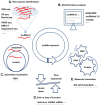LncRNAs: From Basic Research to Medical Application
- PMID: 28367094
- PMCID: PMC5370437
- DOI: 10.7150/ijbs.16968
LncRNAs: From Basic Research to Medical Application
Abstract
This review aimed to summarize the current research contents about long noncoding RNAs (lncRNAs) and some related lncRNAs as molecular biomarkers or therapy strategies in human cancer and cardiovascular diseases. Following the development of various kinds of sequencing technologies, lncRNAs have become one of the most unknown areas that need to be explored. First, the definition and classification of lncRNAs were constantly amended and supplemented because of their complexity and diversity. Second, several methods and strategies have been developed to study the characteristic of lncRNAs, including new species identifications, subcellular localization, gain or loss of function, molecular interaction, and bioinformatics analysis. Third, based on the present results from basic researches, the working mechanisms of lncRNAs were proved to be different forms of interactions involving DNAs, RNAs, and proteins. Fourth, lncRNA can play different important roles during the embryogenesis and organ differentiations. Finally, because of the tissue-specific expression of lncRNAs, they could be used as biomarkers or therapy targets and effectively applied in different kinds of diseases, such as human cancer and cardiovascular diseases.
Keywords: cancer; cardiovascular diseases; lncRNA; molecular biomarker; therapy strategy.
Conflict of interest statement
Competing Interests: The authors have declared that no competing interest exists.
Figures



Similar articles
-
The emerging roles of long noncoding RNAs in common cardiovascular diseases.Hypertens Res. 2015 Jun;38(6):375-9. doi: 10.1038/hr.2015.26. Epub 2015 Mar 12. Hypertens Res. 2015. PMID: 25762413 Review.
-
LncRNAs and neoplasia.Clin Chim Acta. 2015 Apr 15;444:280-8. doi: 10.1016/j.cca.2015.02.046. Epub 2015 Mar 5. Clin Chim Acta. 2015. PMID: 25748036 Review.
-
Long noncoding RNAs in cardiovascular diseases.Circ Res. 2015 Feb 13;116(4):737-50. doi: 10.1161/CIRCRESAHA.116.302521. Circ Res. 2015. PMID: 25677520 Review.
-
A brief review on long noncoding RNAs: a new paradigm in breast cancer pathogenesis, diagnosis and therapy.Tumour Biol. 2016 Feb;37(2):1479-85. doi: 10.1007/s13277-015-4572-y. Epub 2015 Dec 11. Tumour Biol. 2016. PMID: 26662315 Review.
-
Clinical prospects of long noncoding RNAs as novel biomarkers and therapeutic targets in prostate cancer.Prostate Cancer Prostatic Dis. 2016 Mar;19(1):14-20. doi: 10.1038/pcan.2015.48. Epub 2015 Oct 27. Prostate Cancer Prostatic Dis. 2016. PMID: 26503110 Review.
Cited by
-
The small peptide world in long noncoding RNAs.Brief Bioinform. 2019 Sep 27;20(5):1853-1864. doi: 10.1093/bib/bby055. Brief Bioinform. 2019. PMID: 30010717 Free PMC article. Review.
-
STAT1-induced upregulation of lncRNA KTN1-AS1 predicts poor prognosis and facilitates non-small cell lung cancer progression via miR-23b/DEPDC1 axis.Aging (Albany NY). 2020 May 12;12(9):8680-8701. doi: 10.18632/aging.103191. Epub 2020 May 12. Aging (Albany NY). 2020. PMID: 32396871 Free PMC article.
-
Emerging roles of non-coding RNAs in the pathogenesis, diagnosis and prognosis of osteosarcoma.Invest New Drugs. 2018 Dec;36(6):1116-1132. doi: 10.1007/s10637-018-0624-7. Epub 2018 Aug 6. Invest New Drugs. 2018. PMID: 30079443 Review.
-
Cardiomyocyte mitochondrial dynamic-related lncRNA 1 (CMDL-1) may serve as a potential therapeutic target in doxorubicin cardiotoxicity.Mol Ther Nucleic Acids. 2021 Aug 19;25:638-651. doi: 10.1016/j.omtn.2021.08.006. eCollection 2021 Sep 3. Mol Ther Nucleic Acids. 2021. PMID: 34589283 Free PMC article.
-
The long noncoding RNA LUCAT1 promotes colorectal cancer cell proliferation by antagonizing Nucleolin to regulate MYC expression.Cell Death Dis. 2020 Oct 23;11(10):908. doi: 10.1038/s41419-020-03095-4. Cell Death Dis. 2020. PMID: 33097685 Free PMC article.
References
-
- Kapranov P, Cheng J, Dike S, Nix DA, Duttagupta R, Willingham AT. et al. RNA maps reveal new RNA classes and a possible function for pervasive transcription. Science. 2007;316:1484–8. - PubMed
Publication types
MeSH terms
Substances
LinkOut - more resources
Full Text Sources
Other Literature Sources

